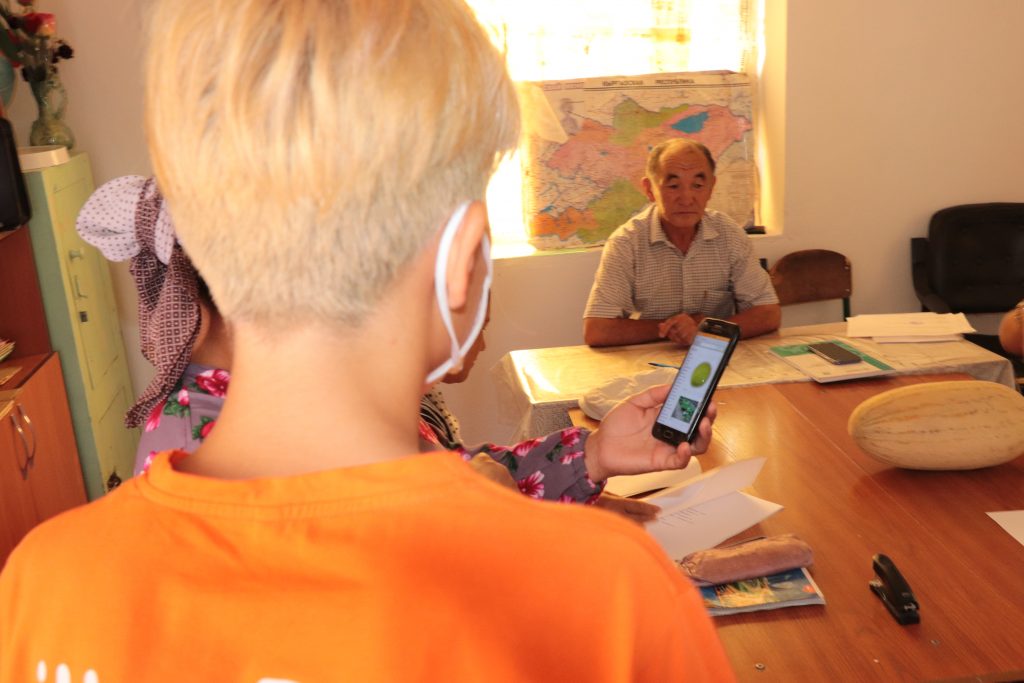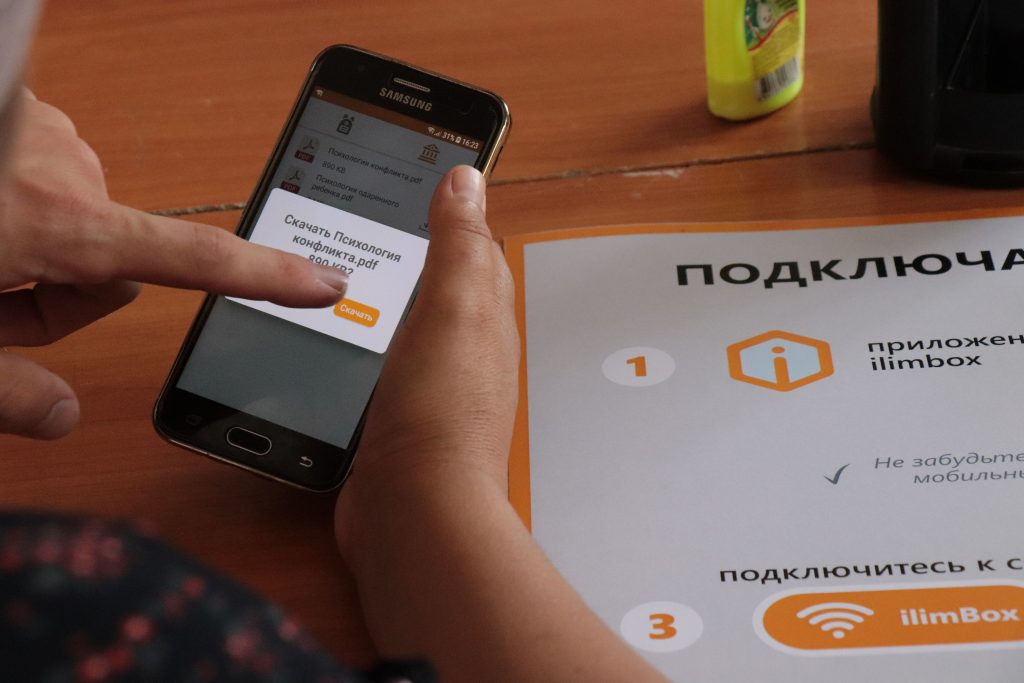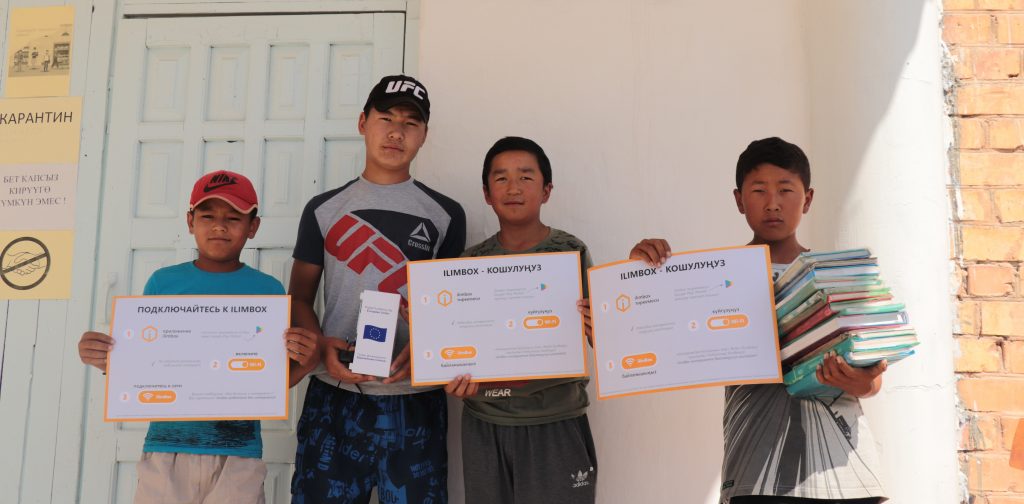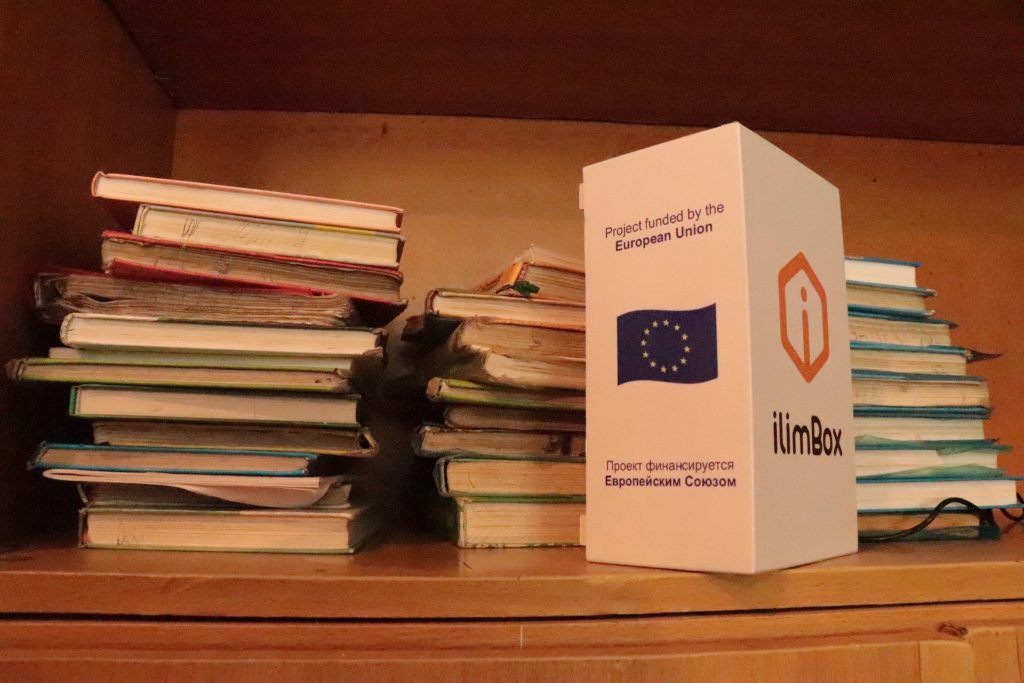At the end of August, the “ilimBox” team, with the financial support of the European Union, installed 22 ilimBox devices in the border villages of Batken region.
Batken District
The first devices were installed in the schools of the Batken District, namely the villages of Chek, Zhagy-Zher, Dobo, and Buzhum. In the village of Dobo, the teachers treated us with melons right from their own garden. Therefore, talking about offline Wikipedia in Kyrgyz, we decided to search for the word “koon” (eng: melon) to show how this resource works. Residents of these border villages are mainly engaged in agriculture, planting watermelons, melons, pumpkins.

Photo: melon and ilimBox
The villages of Gaz, Tayan, Charbak, and Kyshtut are located in the north-east of the city of Batken on the border with the Sokh region, which is an exclave of Uzbekistan. Since the border with Uzbekistan was closed, we drove along the mountain bypass road. The road was not paved, and we could only observe the rocky slope of the mountains and dry fields from the car window. But the first impression was misleading: as soon as we descended the mountains and went to the first school, we were greeted by “Scandinavian” villages – mountain rivers, trees, winding roads, and cool transparent air. An interesting discovery for our team in this region was the village of Kyshtut, whose residents do not see the sun for 40 days of winter because this village is located between the mountains, which block the low sun in winter.

Photo: Map of villages on the border with Sokh region where ilimBox was installed
The last schools in the Batken district were the schools of the Samarkandyk aiyl okmotu, namely the villages of Samarkandek, Ak-Sai and Min-Oruk. All schools in this region are located on the border with Tajikistan. But, searching for the basic school named after Baba Gaipov in the village of Min-Oruk, we drove along the Tajik highway and for a long time could not find the right school. We were helped by the boys, who told us that the border here does not pass through the territory but through houses. So, side-by-side were the gates from the “Tajik” and “Kyrgyz” houses. Local residents shared, due to the staggered arrangement of houses in different countries, conflicts often arise, which sometimes lead to shootings.

Photo: school teacher of Min-Oruk downloads the book “The Psychology of Conflict”
Leilek and Kadamjai districts
Having completed the installation of devices in the Batken region, we went to Leilek. About 30% of the area of the Leilek region belongs to the territory of high mudflow hazard. The weather in this region is colder than in the whole region, after the hot Batken days, Isfana greeted us with fog and cold rain.
In total, in Leilek region, we installed 6 ilimBox devices in the villages of Ak-Bulak, Kara-Bulak, Katyran and Leilek.
I remember the village of Katyran the most remote villages in the Leilek region. Despite the pouring rain, about 20 teachers patiently waited for our arrival. While waiting for the download of the ilimBox Android application, we asked the teachers’ opinions on how distance learning would affect the educational level of children. Most of the teachers were concerned that after school children from the villages usually graze cattle, work in the fields or do housework. If before the pandemic, teachers could oblige children to attend school and complete assignments, now the responsibility lies entirely on parents, who can higher prioritize the work in the field than education.

Photo: Children with books and ilimBox
Completing our trip to Batken, we installed 2 devices in the Kadamjai district, in the villages of Kara-Dobo and Kyzyl-Korgon.
Residents of the Kyzyl-Korgon village of the Akturpak aiyl okmotu are engaged in the cultivation of Batken rice, which is highly valued for its taste and useful properties. Most of the rice is exported to Uzbekistan and Tajikistan. We wondered how the Covid-19 pandemic affected their way of life. A teacher from the Kyzyl-Korgon school shared that they attracted Uzbek citizens from the Sokh region to work in the rice fields, but this spring, when work began in the fields, the borders had already closed. Therefore, they invited residents of neighboring aiyl okmotu who were left without work due to the Covid-19 pandemic. Thus, Akturpaksiy aiyl okmotu not only protected their crops but also provided neighboring villages with jobs.

Books in the library and electronic library ilimBox
When visiting schools, the participants were requested to install the ilimBox Android application. Some teachers used mobile Internet, and others the school’s wi-fi. Both options provided very low speed, which is why we waited 20-30 minutes for one 59 MB application to load. For comparison, pdf books on the site https://www.kitep.edu.gov.kg reach 600 MB.
22 ilimbox devices were installed in Batken region in the schools below:
INCOMPLETE SECONDARY SCHOOL DOBO – 131 students
INCOMPLETE SECONDARY SCHOOL B. GAYIPOVA – 180 students
BASIC SCHOOL “TASH-TUMSHUK” – 62 students
SECONDARY EDUCATIONAL SCHOOL NAMED AFTER V. LENIN – 1512 students
SCHOOL GYMNASIUM NAMED AFTER S. KOZHOBAEV – 326 students
SECONDARY EDUCATIONAL SCHOOL BUZHUN – 798 students
SCHOOL GYMNASIUM BUZHUN – 172 students
SECONDARY EDUCATIONAL SCHOOL GAS – 350 students
SECONDARY EDUCATIONAL SCHOOL KYSHTUT – 192 students
SECONDARY EDUCATIONAL SCHOOL ZHANYZHER – 244 students
SECONDARY EDUCATIONAL SCHOOL TAYA – 242 students
SECONDARY EDUCATIONAL SCHOOL CHECKS – 789 students
SECONDARY EDUCATIONAL SCHOOL ACCESS – 52 students
SECONDARY EDUCATIONAL SCHOOL NAMED AFTER A. TOPCHUEV – 77 students
SECONDARY EDUCATIONAL SCHOOL AKBULAK B.M – 84 students
SECONDARY EDUCATIONAL SCHOOL KARA-BULAK – 422 students
SECONDARY EDUCATIONAL SCHOOL “KATRAN” – 163 students
KOZUBAGLAN SECONDARY EDUCATIONAL SCHOOL – 608 students
SECONDARY EDUCATIONAL SCHOOL KOITASH – 146 students
SECONDARY EDUCATIONAL SCHOOL LEYLEK – 224 students
SECONDARY EDUCATIONAL SCHOOL BABUR – 327 students
SECONDARY EDUCATIONAL SCHOOL “KYZYL-KORGON” – 293 students


